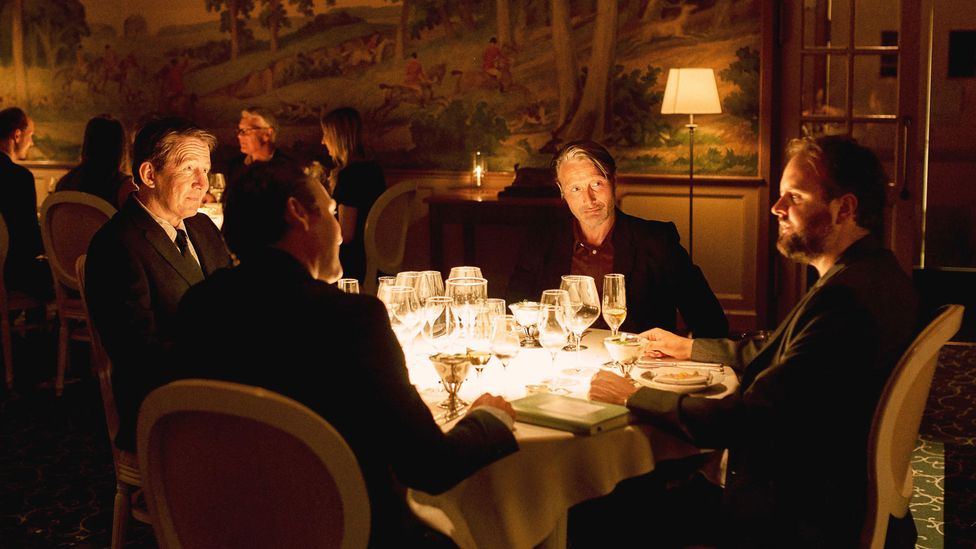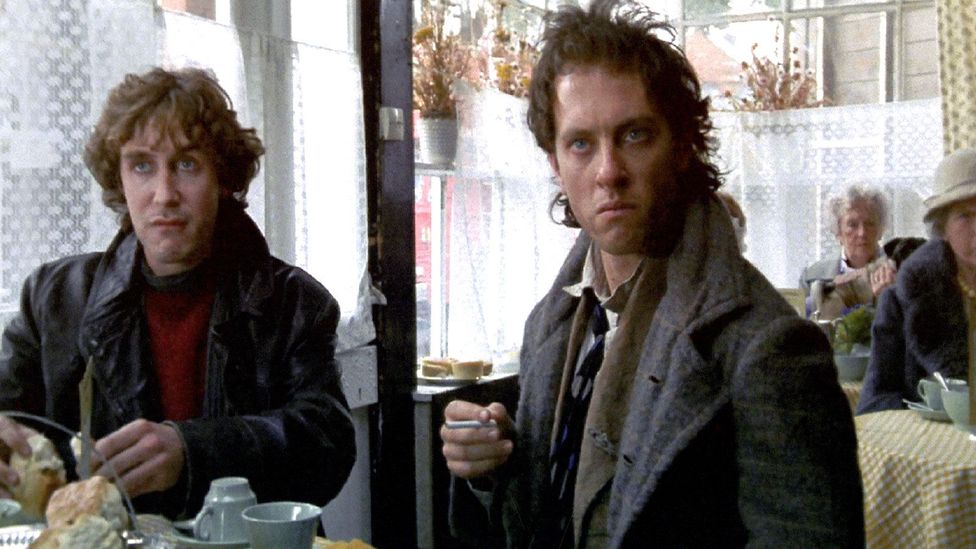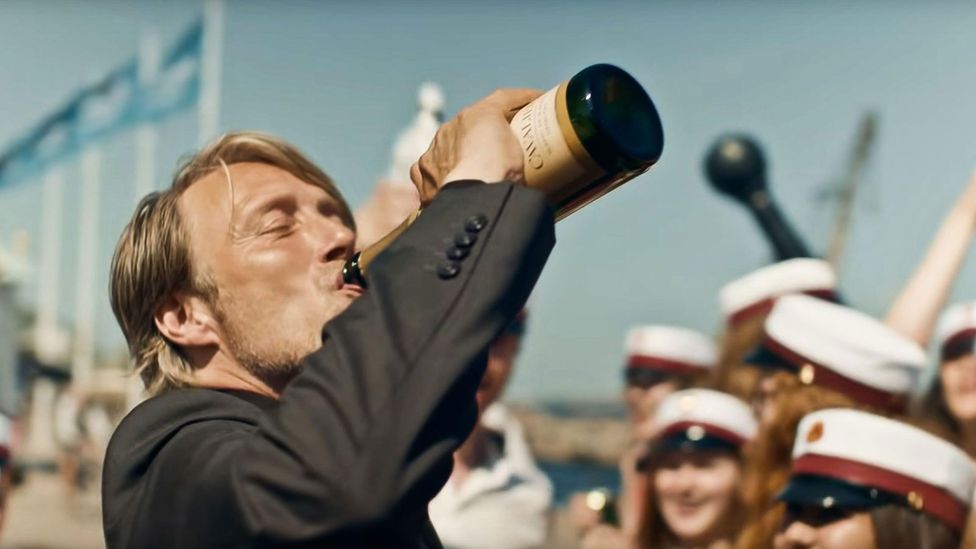Sometimes you wonder if actors are acting at all. You know deep down that they're reciting lines from a screenplay, and being guided by a director who's sitting nearby. But, at their most convincing, they can make you think that they are genuinely upset/euphoric/madly in love, and that there's no pretence involved. The latest film to prompt this kind of uncertainty is Another Round (Druk), directed by Thomas Vinterberg (Festen, The Hunt). Denmark's entry for the best international feature category at the Oscars, Vinterberg's piquant mid-life crisis tragicomedy stars Mads Mikkelsen (Casino Royale, Doctor Strange) as one of four jaded teachers who experiment with being under the influence of alcohol throughout the working day. Their intoxication seems so utterly authentic – one scene, featuring Mads Mikkelsen drunk-dancing on a pier, has been shared widely on social media for this reason. Whether they are mildly tiddly or wildly blotto, some viewers will ask themselves: were the actors really drunk?
More like this:
- Will Hollywood ever show the 'real India'?
- Why biopics often go so wrong
- A revolution that changed cinema
The answer is an emphatic no. "We were firm about that from the beginning," Mikkelsen tells BBC Culture via Zoom. "If you do one or two scenes in a film when you are supposed to be very drunk, you might have a beer to get the feel of it, but we were doing this every day for 60 days, so that would be a no-go. There were also days when we would be drunk for three hours in one scene, and then driving a car sober in the next. You can't do that if you've had a beer." Vinterberg goes further. On a video call from Copenhagen, he dismisses the idea of actors getting drunk for drunk scenes as "amateurism". But how else can you be believably pie-eyed in a film? "As with anything that looks real on screen," he says, "it's a result of hard work and a lot of repetition."

The actors in Another Round spent two days drinking on camera, then studying the footage (Credit: Alamy)
We have all heard about actors who were sloshed while playing sober characters. But if you are playing sloshed characters, it seems, it's best to be sober. A special mention in this regard must go to Richard E Grant, the star of cult British film Withnail & I, because he had never been drunk in his life until he made the film. The actor is medically intolerant to alcohol, but Bruce Robinson, the writer-director, felt that he should have some experience of Withnail's booziness. Grant dutifully worked his way through two bottles of champagne, and was retching in agony for hours while his wife asked, "Why don't you just try acting?"
The actors in Another Round already had real-life experience to draw from; as Mikkelsen says, "We all carried a backpack full of knowledge of what being drunk was like." Nonetheless, Vinterberg put them through an "alcohol boot camp". As part of the rehearsal process, they spent two days drinking on camera, and measuring their blood alcohol concentration with digital breathalysers (just as the characters do in the film). Afterwards, they studied the footage to ensure that they were simulating the right degree of inebriation in each scene. The most enlightening footage, says Mikkelsen, was of the periods when they were still fairly sober. "If you're drinking yourself, rather than observing, it feels fine and natural if you've only had two or three beers. You don't see any signs of drunkenness. But if you're watching from the outside, you can clearly see and hear it in people's voices, the way they're a bit more loud, and the way they move a little more freely and loosely. At that socially acceptable level, it's just about little nuances, but the signs are there. When you're acting those scenes, you bring your shoulders down and you relax a little. I have a slight lisp, so I let that go a little, too."
You can see characters in this state in plenty of classic films. Two of the best examples are Chishū Ryū in Yasujiro Ozu’s Tokyo Story, complaining about his grown-up children as he props up the bar, his head lolling; and Humphrey Bogart, cursing all the gin joints in all the towns in all the world in Casablanca. It's fair to say that Bogart, unlike Richard E Grant, didn't need any training for the scene. According to one apocryphal story, his last words were, "I should never have switched from Scotch to Martinis."

In order to experience drunkenness before playing Withnail, Richard E Grant – who is intolerant of alcohol – drank two bottles of champagne and was violently ill (Credit: Alamy)
The plot of Another Round, co-written by Vinterberg and Tobias Lindholm, has the four men increasing their alcohol intake, day by day. "We got the card which the police use to recognise how drunk you are," says Vinterberg. "It’s very specific. At 0.09 [per cent blood alcohol concentration] you get a bit sleepy, at 0.1 you get emotional, at 0.11 or 0.12 you sometimes start singing. There's a system to this thing."
So what are the filmmakers' tips for acting tipsy?
"Most actors will tell you that the secret of playing slightly drunk is to approach it as you do in your personal life," says Mikkelsen, "which is to try your best not to appear drunk. You move a fair bit slower, you're more cautious, a little more precise." The next stage of drunkenness is when "nobody's listening anymore, it's just people talking very, very loud". And that's another reason why actors should stay sober when making a film: "Otherwise you wouldn't listen to your director, so it wouldn't work at all."
A few units further on, the characters are plastered, trolleyed, and three sheets to the wind, a condition that is a staple of both comedy and tragedy in the movies. At one extreme, there is the cuddly Dudley Moore in Arthur, stumbling into a hedge, and snarling, "You’re a hedge!" At the other, there is the pathetic Jackson Maine (Bradley Cooper), wetting himself at the Grammys as Lady Gaga's character Ally accepts her trophy. But Mikkelsen didn’t watch other films for inspiration. Instead, he "watched a lot of YouTube, which for some reason involved a lot of Russians filming themselves when they're absolutely hammered". As educational as these clips were, he and his colleagues soon hit upon another issue. "If you see some of the YouTube videos of drunk people fighting," says Vinterberg, "it just looks like bad comedy. The reality would be too much for a film. There's a limit to how much you can push it – but we went to that limit."

Instead of watching other actors playing drunk, Mads Mikkelsen "watched a lot of YouTube" for inspiration (Credit: Alamy)
To help themselves seem properly dizzy, the actors would spin around before each take – well, some of them. "I don't think Mads did that," notes Vinterberg. "It was beneath him." They also made use of "very painful" eyedrops to give them the requisite bleary red eyes, and shoulder pads for when they bumped into walls. Being blind drunk can be dangerous, after all. In one of cinema's most sublime films about someone who's sozzled, One A.M., Charlie Chaplin’s genius for slapstick allows him to tumble spectacularly without breaking any bones. On Another Round, the solution was to have crash mats on the floor, just out of shot, so that the actors could fall over whenever the mood took them. "Very drunk people don't use their hands to stop themselves when they fall down," explains Mikkelsen, "they just use their teeth or their faces, so we were keen on having mats around the place."
According to Vinterberg, though, "the most important thing" when you’re playing someone pickled is not fooling the viewer but fooling yourself. In the opening scene of Another Round, some teenagers knock back cratefuls of beers and sprint around a lake. The beers were all alcohol-free, says Vinterberg, but the young actors were so elated by the atmosphere that "they got crazy". The same sort of hypnosis happened to the lead actors during one raucous scene in a pub. "It's an illusion. Your brain processes it as, 'I'm in the surroundings where I'm normally in that kind of state,' and it brings you into that state." So maybe, in a sense, the actors did get drunk for the drunk scenes: it's just that they managed it without a drop of alcohol.
Another Round is released internationally on 5 February 2021.
Love film and TV? Join BBC Culture Film and TV Club on Facebook, a community for cinephiles all over the world.
If you would like to comment on this story or anything else you have seen on BBC Culture, head over to our Facebook page or message us on Twitter.
And if you liked this story, sign up for the weekly bbc.com features newsletter, called The Essential List. A handpicked selection of stories from BBC Future, Culture, Worklife and Travel, delivered to your inbox every Friday.
"how" - Google News
January 26, 2021 at 07:04AM
https://ift.tt/3c7H4fz
How do you act drunk on screen? - BBC News
"how" - Google News
https://ift.tt/2MfXd3I
https://ift.tt/3d8uZUG
Bagikan Berita Ini














0 Response to "How do you act drunk on screen? - BBC News"
Post a Comment